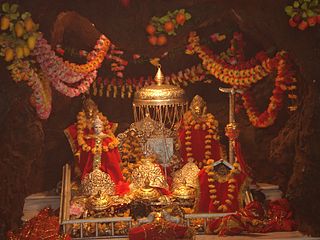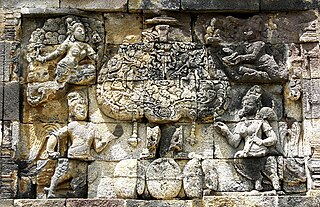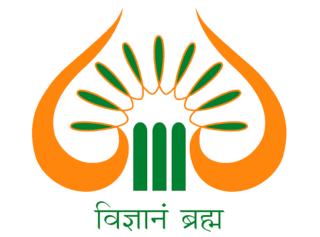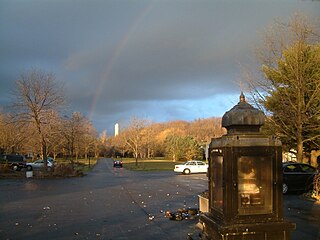Trikuta in Jammu

Another Trikuta is located near the city of Katra, Jammu and Kashmir. Trikuta, the triple peak, is where the holy shrine of Vaishno Devi can be found. [1]
Trikuta is a three-peaked mountain in Hindu mythology. It is one of the twenty mountains surrounding Maha Meru (Mount Meru) the home of Brahma. The height is said in the Bhagavata Purana to be 10,000 yojanas, and the three peaks are iron, silver and gold. The mountain is believed to be the second home of the divine goddess Vaishno Devi. She was created with the divine power of the mother Goddesses Tridevi to end evil; hence, the mountain is called Trikuta.[ citation needed ]

Another Trikuta is located near the city of Katra, Jammu and Kashmir. Trikuta, the triple peak, is where the holy shrine of Vaishno Devi can be found. [1]

Mount Meru, also known as Sumeru, Sineru, or Mahāmeru, is the sacred five-peaked mountain of Hindu, Jain, and Buddhist cosmology and is considered to be the centre of all the physical, metaphysical, and spiritual universes. The mountain is also mentioned in some scriptures of non-Indian based religions such as Taoism, which was influenced by the arrival of Buddhism in China. There is no clear identification of Mount Meru with a particular geophysical location but it is always located in Himalayan or Aravalli ranges.

Vaishno Devi is a manifestation of the Hindu mother goddess Lakshmi in some beliefs. Vaishno Devi is worshipped as a combined avatar of the goddesses Mahakali, Mahalakshmi, and Mahasarasvati. Additionally, she is seen as the potency of Hari or Vishnu. Vaishnavi is the worshipper of Vishnu who meditates to him on the Trikut mountain and awaits his arrival.

Katra is a city and Tehsil in the Reasi district of the Indian union territory of Jammu and Kashmir, situated at the foot of the Trikuta Mountains, where the shrine of Vaishno Devi is located. Katra is located 24 km from the town of Reasi, 42 km (26 mi) from the city of Jammu and around 685 km (426 mi) north of the national capital New Delhi and is the base for pilgrims visiting the Mata Vaishno Devi Temple.

In astronomy, axis mundi is the Latin term for the axis of Earth between the celestial poles. In a geocentric coordinate system, this is the axis of rotation of the celestial sphere. Consequently, in ancient Greco-Roman astronomy, the axis mundi is the axis of rotation of the planetary spheres within the classical geocentric model of the cosmos.

Kalpavriksha is a wish-fulfilling divine tree in religions like Hinduism, Jainism, and Buddhism. In Buddhism, another term, ratnavṛkṣa, is also common. Its earliest descriptions are mentioned in Sanskrit literature. It is also a popular theme in Jain cosmology and Buddhism.

Himavat is the personification of the Himalayan mountains in Hinduism. He is the guardian deity of the Himalayas, and finds mention in the epic Mahabharata and other Hindu scriptures.

Shri Mata Vaishno Devi University, commonly referred to as SMVD University or SMVDU, is a Government Owned Higher Institution/University located in Katra, Reasi district, Jammu and Kashmir, India. It was founded in 1999, as fully residential and technical university, a Public University recognised by UGC under section 2(f) and 12(B) and is established on more than an 470-acre (190 ha) residential and provides technical education in the field of engineering, architecture, science, management, philosophy and other subjects, with all technical courses recognised by AICTE, University Grants Commission (India), National Board of Accreditation and Council of Architecture.

Sacred mountains are central to certain religions, and are usually the subjects of many legends. For many, the most symbolic aspect of a mountain is the peak because it is believed that it is closest to heaven or other religious realms. Many religions have traditions centered on sacred mountains, which either are or were considered holy or are related to famous events. In some cases, the sacred mountain is purely mythical, like the Hara Berezaiti in Zoroastrianism. Mount Kailash is believed to be the abode of the deities Shiva and Parvati, and is considered sacred in four religions: Hinduism, Bon, Buddhism, and Jainism. Volcanoes, such as Mount Etna in Italy, were also considered sacred, Mount Etna being believed to have been the home of Vulcan, the Roman god of fire and the forge.

In Hinduism, the yatra (pilgrimage) to the tirthas has special significance for earning the punya needed to attain the moksha (salvation) by performing the darśana, the parikrama (circumambulation), the yajna, the Dhyana, the puja (worship), the prarthana, the dakshina, the seva, the bhandara, etc. These sacred places are usually located on the banks of sacred waters, such as sacred rivers or their tributaries, the kundas, the ghats, or the stepwells, or the temple tanks.
Nagrota is a town located in the Jammu district of Jammu and Kashmir in India. It is located on National highway 44 between Jammu city and Udhampur. It is situated on the bank of River Tawi. Nagrota along with Kashmiri Pandit Migrant town of Jagti straddle the national highway. Nagrota is the first shrine stoppage for Shri Mata Vaishno Devi. The Kol-Kandoli temple is a mandate for completing the Shri Mata Vaishno Devi pilgrimage. Nagrota has an extension of Jammu Industries having Oil Depots and Godowns.It serves as headquarter of the XVI Corps (India) also known as the 'White Knight Corp'.

Devipuram is a Hindu temple complex located near Visakhapatnam, Andhra Pradesh, India. Belonging primarily to the Shakta school of Hinduism, it is dedicated to the goddess Sahasrakshi, and her consort Kameshwara.

Yatra, in Indian-origin religions, Hinduism, Buddhism, Jainism and Sikhism, generally means a pilgrimage to holy places such as confluences of sacred rivers, sacred mountains, places associated with Hindu epics such as the Mahabharata and Ramayana, and other sacred pilgrimage sites. Visiting a sacred place is believed by the pilgrim to purify the self and bring one closer to the divine. The journey itself is as important as the destination, and the hardships of travel serve as an act of devotion in themselves.

The Rajarajeswari Peetam in Rush, New York is a Sanathana Dharma temple that practices the teachings of SriVidya. Sri Chaitanyananda Natha Saraswathi is the peetathipathy of the temple along with Gnanamba his wife. Aiya is a disciple of Sri Amritananda Natha Saraswathi who is the Peetathipathy of the Devipuram temple. The temple was founded in Zambia, then moved to the Aiya's home in Rush in New York state before the current, purpose-built temple was constructed.

Jwala/Jwala Ji is a Hindu goddess. The physical manifestation of Jwala is always a set of eternal flames, and the term Jvala means flame in Sanskrit and ji is an honorific used in the Indian subcontinent.

Shri Mata Vaishno Devi Katra railway station is a railway station on the Jammu Udhampur Srinagar Baramulla Railway Link in the Indian Union Territory of Jammu and Kashmir. It mainly serves for the town of Katra where the major hindu divine temple Shri Mata Vaishno Devi is situated which is visited by millions of travellers per month with the help of this station and its frequent special trains connectivity from all over India. The station belongs to the Firozpur division of Northern Railway zone in Jammu and Kashmir.
Vaishnodevi Temple at Rourkela is a replica of the original Temple of Vaishnodevi of Jammu and is situated on the top of the Durgapur Hill facing towards Rourkela Steel Plant. Bhairabanath Temple is situated near Vaishodevi Temple on the hill.
The Banganga is a river of northern India. It is an important tributary of the Chenab River. It flows through Katra, Jammu and Kashmir. The river originates from the southern slope of the Shivalik range of the Himalayas. It's an important stop for Hindu devotees on the ‘’’Vaishno Devi’’’ pilgrimage, where many bathe before continuing their journey.

Jag Janani Maa Vaishno Devi – Kahani Mata Rani Ki, is an Indian mythological television series, which premiered on 30 September 2019 on Star Bharat. It is based on the life of Goddess Vaishno Devi. The series is produced by Rashmi Sharma and Pawan Kumar Marut under Rashmi Sharma Telefilms. The show aired its last episode on 2 October 2020.

Vaishno Devi Temple, also known as the Shri Mata Vaishno Devi Temple and Vaishno Devi Bhavan, is a Hindu temple located in Katra, Jammu and Kashmir, dedicated to Vaishno Devi, a manifestation of Mahakali, Mahalakshmi, and Mahasarasvati. It is located on the Trikuta mountain at 5,000 feet / 1,500 meters elevation. The Shakti tradition considers it to be a Shakti Pitha. The temple is governed by the Shri Mata Vaishno Devi Shrine Board (SMVDSB) and has been chaired by the Governor of Jammu and Kashmir since August 1986.

On 1 January 2022, 12 people were killed and 16 others injured in a crowd crush near to Gate No. 3 at the Vaishno Devi Temple in Katra, Jammu and Kashmir, northern India.